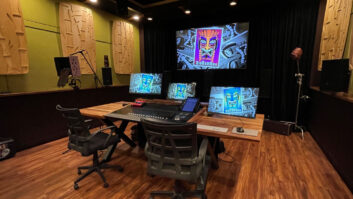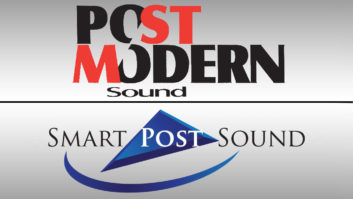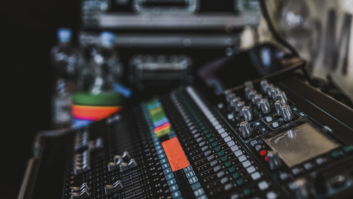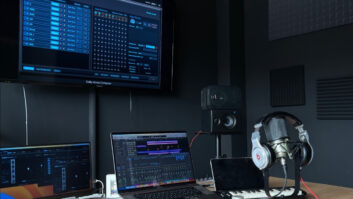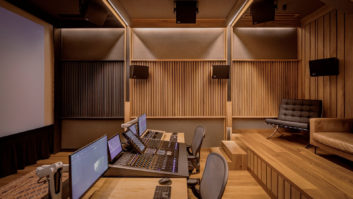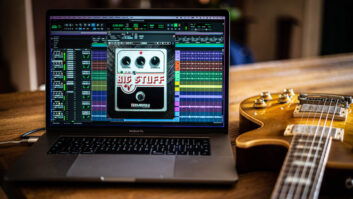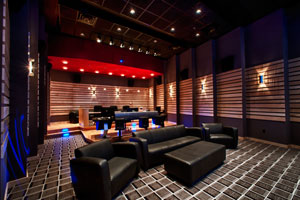
The rear wall and parts of the side wall on the Dolby Stage employ Manzella’s “high bass trapping” system based around the Helmholz slats to cover the area between 100 to 300 Hz.
Roy Machado has a good thing going in Dallas. He arrived from Atlanta back in the mid-1980s to study music at the world-renowned University of North Texas, and today he is the owner/president/creative director of the biggest, baddest post house in town, with all-new facilities, including the region’s first Dolby-approved dub stage, and work coming in from across the country.
It’s actually Machado’s fourth “opening” of Dallas Audio Post since the first iteration debuted humbly in 1994. The company has grown steadily and organically, self-financed, never living beyond its means. Expanding as the business demanded it, not to try to get the business. In March 2012, after years of leasing spaces around town, eventually outgrowing them, he and his team moved into 10,500 square feet of brand-new, ground-up construction, a five-studio facility to call their own.
“Dallas is a big metro area, bigger than what most people think,” Machado says. “It has a vibrant local economy that largely withstood the downturn. There is a tremendous amount of corporate activity, audio for TV and film, sports teams, amazing musicians and live events. A real wide variety of clients who need audio services. By 2010 we were bursting at the seams and we needed more recording space. But mostly we needed a dedicated mixing space.”
That mixing space, dubbed the Dolby Stage, is featured on this month’s cover, and it became the focus for how the rest of the warehouse-style building would be laid out, most importantly in determining the overall height. After spending a good 18 months finding the right location and refining a “limited, aggressive, self-financed” budget, Machado called in Fran Manzella of FM Design for some acoustic expertise.
Design Criteria
“The advantage of ground-up construction is that you get to do what you want to do; the disadvantage of ground-up construction is that you get to do what you want to do,” Manzella says. [Laughs.] “Sometimes the most difficult project is the one that starts with a blank piece of paper. An existing facility often will tell you what it should be. But in this case, Roy was the ideal client. He is articulate about what he wants, and he’s educated enough to listen, to understand both the limits and the possibilities.”
Manzella did inherit a few limits regarding the overall structure, but nothing that affected the Dolby Stage. He knew from the beginning that Machado had a long-standing relationship with Acoustic Systems (Austin) and was going to be bringing over two modular studios and three vocal booths from the previous leased space. But he also wanted three new studios and additional recording capability. It would be, from the start, all parties agreed, a combination of traditional and modular construction.
“We had these isolation shells,” Machado explains, “and we knew we could build new outer shells, new floors and integrate them into the building, but not necessarily for the same purpose. One of the 5.1 mix rooms from the old place became our ADR/Foley stage at the new building, with pits built into the new poured slab. All the floors are floated, and everything is isolated; we just kept the interior shells.”
Besides the 5.1 room, a stereo music room was also brought over and integrated. Three new control rooms were built—Dolby Stage, stereo music room, all-new 5.1 mix room—and additional ADR booths were added. Voice recording is a huge part of the Dallas Audio Post business, and it was crucial to Machado that engineers be able to record anywhere, or pull sessions up in any room.
“The client diversity has helped us tremendously over the years,” Machado says, admitting that he’s never had a marketing plan or a sales team, relying on quality work and word of mouth. “Roughly 65 percent of our work now comes from outside of Dallas. We have relationships with all the film studios at this point for ADR work in film and episodic TV. We are one of the biggest producers of political spots outside of D.C., we do corporate, all the local professional sports teams, including in-game content. We do TV and radio spots, toy design and game design, and in 2010, we had seven independent films, with soup-to-nuts audio.
“With all that variety, we had to be sure that our rooms translated, both within the facility and to the outside world,” he continues. “That’s one of the reasons we put a second, near/mid-field monitoring system on the Dolby Stage, so that we could work in film or TV at the switch of a button. We might have Cinemark coming in from Plano to do a 5.1 mix telling you to get your popcorn, then switch in the afternoon to agency work on a TV spot. Both of them are mixed in a world-class room.”

Dallas Audio Post owner/president/creative director Roy Machado, left, with studio designer Fran Manzella at the Avid Icon in the Dolby Stage.
The Dolby Stage
Dolby in the U.S. doesn’t really have a “certification,” though they do have recommendations on room dimensions, speaker throw, speaker and screen configuration, number of speaker channels and the like, which lead to a Dolby approval. Dallas Audio Post, at 40×25 with 18-foot ceiling, is not as large as an A-list Hollywood stage, but it exceeds the minimum requirements in all respects.
The Avid Icon console sits two-thirds of the way back in the room, and it’s pretty much all-digital throughout with recording to Pro Tools HDX, but the centerpiece is really the 11.2 Meyer EXP System, known in the vernacular as Acheron.
“One of the real joys for me on this project was working with Dolby and Meyer on the tuning of the room,” Manzella says. “First, Meyer set up the traditional X-curve, because Roy needs to interface with Hollywood and do his own films. But then they also did a flat curve for the 5.1 TV work. Then Coach from Dolby [Tom Ehle] comes in and sets up multiple mics in multiple locations and averages the room. Then I measure. And we all worked together. I am very familiar with room tuning as a staple of our work, and it was still very educational for me.”
Every new room today needs to serve multiple purposes, and both Machado and Manzella knew that the Dolby Stage could not just do feature film and episodic TV work. To ensure the changeover from film/TV to spot work and even radio, they brought in a near-mid-field JBL 6238 5.1 system, on motorized lifts, to monitor when switching to the flat curve.
“We needed the spaces to fit the work that we do,” Machado says. “I never once believed that if we built a Dolby Stage that people would come running. We simply wanted a dedicated mix room where we could do the work that we do, whether we are working on an indie film or a political spot or an original composition.”
Some of that versatility is accomplished in the switch from Meyer EXP Cinema to JBL in the mid-field, but some of it is also accomplished in the back-wall construction, something of a signature for Manzella.
“The back walls in all the normal-size rooms are fairly normal RFZ designs,” Manzella explains. “We have trapping straddling a diffuser system. I like to do these Helmholtz slats over my traps in the back because we get a little more return from the back of the room in the mid and high frequencies, and that’s okay. Then the Helmholz slat-style treatment with deeper trapping behind it covers that area between 100 and 300 Hz very well. A lot of rooms have mud in that 100 to 300 range, and if you don’t dampen that area, I find that it can make an unclear transition from low to midrange. We continued the Helmholz trapping around the side walls because these speakers are now in the far field. You want it to sound even, with no perceptible decay. It’s supposed to sound like a room, whether you are mixing for film or TV.”
So Much More
There are dozens of other stories surrounding the construction and integration, many of them focused on making the space dead quiet throughout. Just a couple of them:
HVAC was considered mission critical; it gets hot in Texas. Machado wanted redundancy, and the team came up with a scheme where the fans were inside in a central mechanical space, the six compressors on the side of the building. A spare unit provided complete backup, with a manifold above the ductwork that allowed instant switching if any one of the six units went down.
Also, Machado is a hands-on guy. His team at Dallas Audio Post handled all of the integration and termination of the wiring and infrastructure, almost entirely Fiber and Cat 6. The old facility closed on a Friday, the new facility opened on Monday morning. A real homegrown effort. The way business has to be done today.
“The heart of our success has been putting out great-sounding work,” Machado concludes. “We live by word of mouth, and everyone here on staff is passionate about what we do. We have a 19-year track record now, and I think our work is getting even better because of the spaces we now have.”
